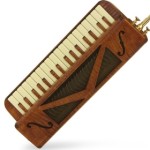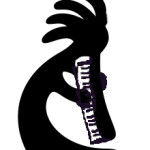Bending Notes
- This topic has 25 replies, 5 voices, and was last updated 9 years, 11 months ago by
 jazzman1945.
jazzman1945.
-
AuthorPosts
-
November 27, 2013 at 11:29 pm #1006
 Alan BrintonParticipant
Alan BrintonParticipantNot something I’ve been successful with yet, though I’m trying. Some people say you can’t bend notes on a melodica, probably the same people who say you can’t tune one. But Jon Batiste, Augustus Pablo, and Hermetto Pascoal obviously do it, as is illustrated in videos you have up here of all three of them. There’s also this guy Jazzman1945ify, who’s probably familiar to people here and who has experimented with blues playing. Also, there’s a guy Peter Jones with a nice video on YouTube:
November 28, 2013 at 2:17 pm #1020 QuetscherParticipant
QuetscherParticipantHi Alan, yes, bending is possible! You just need to press the key only half or so and blow a little stronger (each melodica reed reacts differently, low notes are easier to bend than high notes, and sometimes you have to press the key only minimally, or have to blow really hard, just try out, but remember that when you try to forcefully, this could cause damage with the reeds!)
November 28, 2013 at 8:05 pm #1022 Alan BrintonParticipant
Alan BrintonParticipantThanks for those comments, Quetscher, which confirm what I’ve heard from some others. I’ve been working on it on several melodicas and am beginning to get the idea. It seems to be easier on my cheap Hohner and also without the mouthpiece.
December 20, 2013 at 5:49 pm #1322 DarenKeymaster
DarenKeymasterA little bending video from jazzman…
December 20, 2013 at 7:02 pm #1323 Alan BrintonParticipant
Alan BrintonParticipantI had not seen this, though I’ve been following what Jazzman has been saying about bending. I finally figured out that you need to practice is working up this kind of sound on your melodica. Jazzman1945ify gives links to a couple of his blues/bending audio files here .
I have been finding it easier to get the feel of bending on cheaper melodicas, especially the Suzuki STUDY-32. It’s a melodica it’s easy to get off key on.
December 20, 2013 at 7:02 pm #1324 Alan BrintonParticipantDecember 21, 2013 at 7:17 pm #1339
Alan BrintonParticipantDecember 21, 2013 at 7:17 pm #1339 Alan BrintonParticipantDecember 21, 2013 at 7:33 pm #1340
Alan BrintonParticipantDecember 21, 2013 at 7:33 pm #1340 Alan BrintonParticipantJanuary 13, 2014 at 5:29 pm #1467
Alan BrintonParticipantJanuary 13, 2014 at 5:29 pm #1467 KevinParticipant
KevinParticipantHey Alan,
I’ve been trying a technique on the Yamaha without it’s cover where I slip the pad of my right hand thumb under the front edge of a key blocking it from moving all the way down, pretty much guaranteeing a bent note. I can even adjust the amount of bend somewhat by letting more or less of the fleshy part of my thumb out from under the key.
Of course this only works with the white notes.January 13, 2014 at 7:59 pm #1470 Alan BrintonParticipant
Alan BrintonParticipantYou’re a genius, Kevin! The next Hermeto. So this is a way of controlling the lever, the end of which you’re now not just pushing down; the end of your thumb is impeding the downward motion. But here’s what I just discovered: it’s even easier to do with your thumb on the end of the key after you put your Yamaha back together again. So we’re applying friction at the end of the key. This also works with the black keys, though it’s a bit trickier. For an “all thumbs” guy such as myself, this opens up real possibilities.
January 14, 2014 at 12:08 am #1475 Alan BrintonParticipant
Alan BrintonParticipantActually, and I learned this from my dentist, if you merely brace your thumb against the front of the melodica tray, it’s a bit easier to bend notes.
January 14, 2014 at 12:09 am #1476 KevinParticipant
KevinParticipantHa,ha,ha genius hardly, more like a guy who spends way too much time obsessing on melodicas instead of Oh, I don’t know, doing my job!!! ha,ha 😀
January 22, 2014 at 7:37 pm #1595 QuetscherParticipant
QuetscherParticipantHey big benders,
I’ve tried a lot of bending these days and I’ve found out an improved technique which I’d like to describe to you; maybe I’m right with this, maybe I’m totally mistaken, you will tell me if you may…
First and most important requirement is a playing technique where the hand with all its fingers should rest upon the keyboard while playing, not only the finger that plays a note! (Look at Troy’s irish reel video and you’ll see what I mean, it’s perfect!) Otherwise it will certainly be possible to bend single slow notes but will be very difficult to bend notes in a faster melody.
Now, if you play a note you just press down a key with a finger, meaning only the muscles that move the finger are working and nothing else, right? When bending a note you press the key just a few millimeters maximum which, as each of us knows, is damn difficult. But there’s another way of pressing a key down: if you keep the finger stiff and then turn your wrist, the finger will also move down, but much slower in comparison to the turning movement. So you can move your finger with much more subtlety.
So, let’s have a look on a C-major chord. The fingers rest on C,D,E,F,G and you want to play C-E-G-E-C and so on while bending each C. Try the following: turn(C)-press(E)-press(G)-press(E)-turn(C) and so on. Always try to turn into the direction opposite to the next key you want to press. So it would be best to play turn left(C)-press(E)-press(G)-press(E)-turn left(C) and so on.
Next example: again you want to play C-E-G-E-C and so on while now bending each C and G. Do this: turn left (C)-press(E)-turn right(G)-press(E)-turn left(C) and so on.
With a little luck you will discover that bending now is much easier (at least I hope so!). But take your time, begin slowly, be patient with yourself – and remember: try to keep the fingers on all keys while playing! (I don’t know why exactly this is so important for that technique, but it is – perhaps it keeps the finger that shall be moved more stable…).
January 22, 2014 at 8:12 pm #1597 Alan BrintonParticipant
Alan BrintonParticipantHey Quetscher, that sounds good. I mentioned my dentist earlier. I asked him and his technician how they have such control while working in my mouth. I forget the term they used, but they said it’s all a matter of anchoring the hand, in effect having a reference point from which it’s working. The same kind of principle is applied in handwriting and in art. If you try to write without your wrist resting on your writing surface, for most of us the results aren’t too good. This relates to the other hand and how you’re holding the melodica, for which reason it’s much easier when you’re holding the melodica in your left hand and even up against your body than if you’re playing with a tube and the melodica sitting on a table. It’s not like playing a piano keyboard in any case. I think in terms of squeezing the keys, and so, in addition to resting other fingers on the keyboard, for practice at least, it also helps to secure your thumb under the bottom of the melodica. I think one other thing that applies here is that it’s easier to get the feel of bending by just working on keys rather than (initially) on bending while playing a melody. It doesn’t take musicianship to bend notes. It’s mechanical, and I’m guessing that once an accomplished musician gets the feel of it, incorporating the bending into playing is no big deal.
Thanks! I’ll try what you’re suggesting.
January 23, 2014 at 8:46 pm #1622 QuetscherParticipant
QuetscherParticipantHey Alan, thanks for explaining what I didn’t understand myself to full extent (and what a wise dentist – I wish I had one myself!)
Concerning the idea of placing the thumb beneath the melodica: this reminds me of some button accordionists who play with their thumb staying at the side of the keyboard to stabilize their hand.
I’m looking forward to your experiences with the technique of turning the wrist, for me it works really good. -
AuthorPosts
- You must be logged in to reply to this topic.
